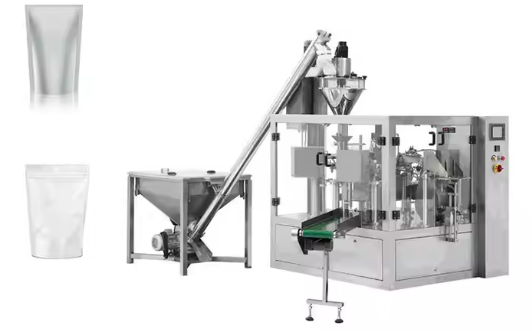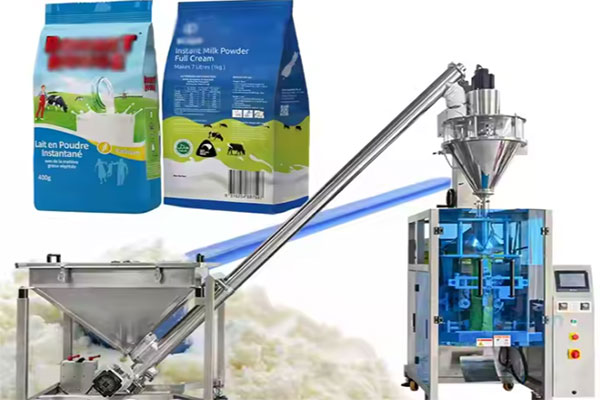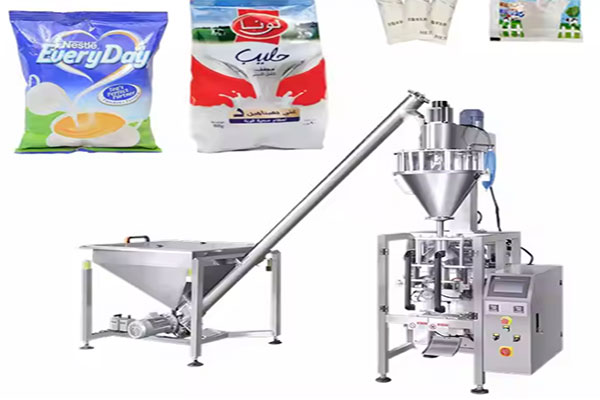What are the packaging bag formats for Powder Packaging Machine?
Saturday September-13 2025 17:55:21
What are the packaging bag formats for Powder Packaging Machine? Powder Packaging Machine use a variety of packaging bag formats, depending primarily on the powder's characteristics and packaging requirements. Powder materials exhibit characteristics such as fluidity, hygroscopicity, and varying particle sizes. Some are also corrosive or easily oxidized, placing high demands on the bag's sealing, moisture resistance, strength, and durability.
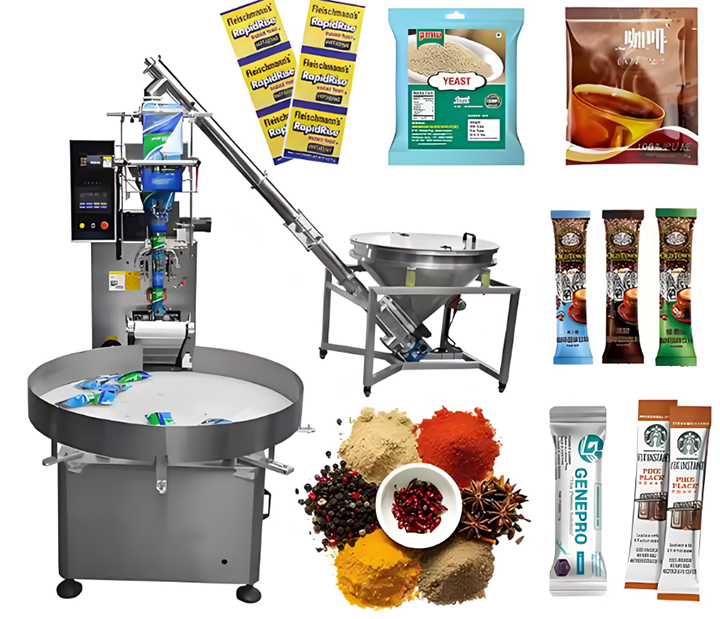
What are the packaging bag formats for Powder Packaging Machine? Classified according to packaging range.Small-format packaging, such as three-side seal bags and four-side seal bags, with capacities ranging from 5 to 200 grams, are commonly used for retail packaging of food powders. Large-format packaging, such as stand-up pouches and gusseted bags, with capacities ranging from 200 to 5,000 grams, are primarily used for bulk storage and transport of chemical and pharmaceutical powders. These bag types meet the packaging needs of various powder products, such as food, chemical, and pharmaceutical powders.
What are the packaging bag formats for Powder Packaging Machine?
The following summarizes several key factors of packaging bags: bag material, bag shape, packaging capacity, packaging size, and applicable materials. To illustrate What are the packaging bag formats for Powder Packaging Machine?

Three-side-seal bags: Made from composite film materials such as PET/PE, PET/AL/PE, and NY/PE, these bags offer excellent moisture and oxygen barrier properties. They are heat-sealed on three sides, leaving one side open for filling. Typical packaging capacities range from 50g to 500g. Package dimensions are customized based on product volume, typically ranging from 80-200mm in width and 100-250mm in height. They are suitable for packaging small-volume, high-value-added powders such as milk powder, coffee powder, pesticide powder, and seasoning powder.
Back-seal bags: Made from materials such as BOPP/PE and PET/PE, these bags are suitable for high-speed bag making and heat-sealing. These bags feature a center-seal back with natural hems on both sides. Capacities range from 10g to 1000g, and dimensions range from 60-180mm in width and 80-300mm in height. They are suitable for packaging medium-flowing powders such as laundry detergent, veterinary drug powder, and feed additives.
Four-side-seal bags: Made from a PET/AL/PE structure, these bags offer excellent barrier properties. These bags are sealed on all four sides and have a regular shape. They typically hold 10g to 300g. Custom sizes are often available, with 120mm x 160mm being a common option. They are suitable for high-end fine powder products such as traditional Chinese medicine powders, facial mask powders, and special additive powders, which require a high degree of sealing and light protection.
Stand-up pouches: Made from PET/AL/NY/PE or paper-aluminum composite film, they offer stiffness and excellent barrier properties. These bags feature a folded bottom for upright display, and some are equipped with zippers. Capacities range from 100g to 2kg, with package sizes ranging from 100mm to 250mm in width and 150mm to 350mm in height. They are suitable for large-volume packaging for home or commercial use, such as protein powder, flour, baking ingredient powder, and industrial filler powder.
Gusseted pouches: Made from materials such as PET/PE, PET/AL/PE, and kraft paper composite bags. The bag has gusseted sides to increase the bag's capacity and make it suitable for stacking. The packaging capacity ranges from 500g to 5kg, and the packaging size is customized based on the weight of the material and the stacking method. It is suitable for bulk products such as rice flour, animal feed powder, and chemical building material powder, where both cost and load-bearing requirements are prioritized.
What is the sealing technology used in powder packaging machines?
The sealing technology of the powder packaging machine affects the type of packaging bags and is also crucial to the quality of packaging. Common technologies include: heat sealing, which fuses the bag opening using a heated pressure head and is suitable for heat-sealable films such as PE and CPP; impulse sealing, which uses a hot wire at a momentary high temperature and is suitable for thick films or heat-sensitive materials; ultrasonic sealing, which is suitable for environmentally friendly new materials or aluminum foil bags and provides a smooth and secure seal; and vacuum and nitrogen sealing, which is required for some high-end powder products to maintain freshness and prevent moisture and oxidation.

Powder Packaging Machine Guide
What are the packaging bag formats for Powder Packaging Machine? The most appropriate packaging type can be selected based on the powder's characteristics. For example, powders with poor flow properties, such as milk powder, are well suited for stand-up pouches, while powders with good flow properties, such as starch, are suitable for three-side seal bags. Moisture-sensitive powders, such as protein powder, require packaging with aluminum-plastic composite film, while easily oxidized powders, such as vitamins, are recommended for vacuum or nitrogen packaging. Furthermore, the packaging bag must be compatible with the machine's film roll specifications and heat-sealing system. Excessively thick bags will compromise the seal, while too thin bags can easily break. High-speed packaging machines require high-strength films such as BOPP or CPP. Back-seal bags are commonly used for vertical packaging machines, while four-side seal bags are suitable for pillow-type machines. Zippered stand-up pouches are suitable for high-value-added products, such as health supplements. Larger packages, such as 25 kg of cement, require reinforced woven bags with a PE liner. For long-distance transportation, moisture- and UV-resistant materials are recommended to balance cost and performance requirements.
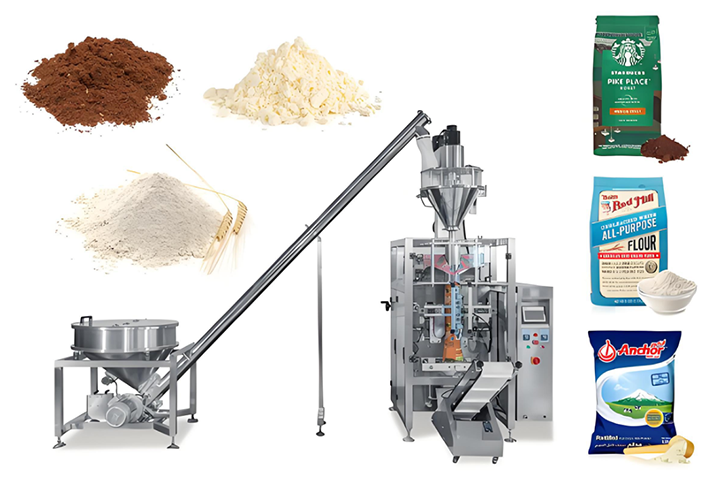
Powder packaging machines can produce a variety of bag formats, from three-side seal, back-seal, and four-side seal bags to stand-up pouches and gusseted bags. Each bag type has its own unique structural advantages and application scenarios. By selecting the right material, capacity, size, and sealing technology, you can not only improve packaging efficiency and product quality, but also help your brand stand out in the market. Powder packaging solutions provide superior packaging services for powder products in various industries. Enterprises should choose the most suitable packaging form based on the characteristics of their products to ensure product quality and enhance market competitiveness.
